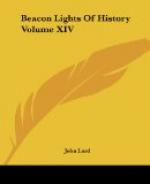In this field, as we shall see, Ericsson did some of his greatest work, and left perhaps his most permanent record for the future.
Ericsson’s life falls most naturally into three periods chronologically or geographically, and likewise into three periods professionally, though the latter mode of subdivision has by no means the same boundaries as the former. The first mode of subdivision gives us the life in Sweden, the life in England, and the life in the United States. The second mode gives us the life of struggle and obscurity, the life of struggle, achievement, and recognition, and the calmer and easier life of declining years with recognition, reward, and the assurance of a life’s work well done.
John Ericsson was born in the province of Vermland, Sweden, in 1803. His father was Olof Ericsson, a mine owner and inspector who was well educated after the standard of his times, having graduated at the college in Karlstad, the principal town of the province. His mother was Britta Sophia Yngstrom, a woman of Flemish-Scotch descent, and to whom Ericsson seems to have owed many of his stronger characteristics. Three children were born: Caroline in 1800, Nils in 1802, and John in 1803. Of John’s earliest boyhood we have but slight record, but there seems to have been a clear foreshadowing of his future genius. He was considered the wonder of the neighborhood, and busied himself day after day with the machinery of the mines, drawing the form on paper with his rude tools or making models with bits of wood and cord, and endeavoring thus to trace the mystery of its operation.
In 1811 the Ericsson family fell upon evil times. Due to a war with Russia, business became disturbed and in the end Olof Ericsson became financially ruined. This brought the little family face to face with the realities of life, and we soon after find the father occupying a position as inspector on the Goeta Canal, a project which was just then occupying serious attention after having been neglected for nearly one hundred years, and nearly three hundred years after it was first proposed in 1526. Through this connection, in 1815, John and Nils Ericsson were appointed as cadets in a corps of Mechanical Engineers to be employed in carrying out the Government’s plans with reference to the canal. During the winter of 1816-17 and at the age of thirteen, John Ericsson received regular instruction from some of his officers in Algebra, Chemistry, Field Drawing, and Geometry, and the English language. Ericsson’s education previous to this seems to have consisted chiefly in lessons at home or from tutors, after the manner of the time. He had thus received instruction in the ordinary branches and in drawing and some chemistry. His training in drawing seems to have been unusually thorough and comprehensive, and with a natural genius for such work, his later remarkable skill at the drawing board is doubtless in no small measure due to the excellent instruction which he received in his early years. His progress in his duties as a young engineer was rapid, and he was soon given employment in connection with the canal-work, involving much responsibility and calling for experience and skill.




